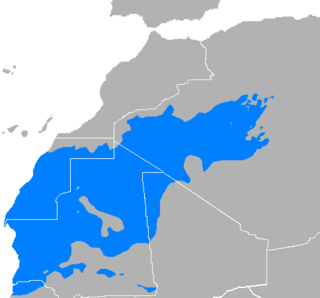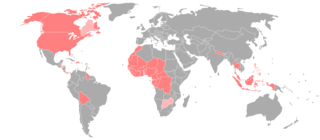 W
WNiger has 11 official languages, with French being the official language and Hausa the most spoken language. Depending on how they are counted, Niger has between 8 and 20 indigenous languages. The discrepancy comes from the fact that several are closely related, and can be grouped together or considered apart.
 W
WAlgerian Saharan Arabic is a variety of Arabic indigenous to and spoken predominantly in the Algerian Sahara. Its ISO 639-3 language code is "aao," and it belongs to Maghrebi Arabic.
 W
WArabic is a Semitic language that first emerged in the 1st to 4th centuries CE. It is now the lingua franca of the Arab world. It is named after the Arabs, a term initially used to describe peoples living in the Arabian Peninsula bounded by eastern Egypt in the west, Mesopotamia in the east, and the Anti-Lebanon mountains and Northern Syria in the north, as perceived by ancient Greek geographers. The ISO assigns language codes to 32 varieties of Arabic, including its standard form, Modern Standard Arabic, also referred to as Literary Arabic, which is modernized Classical Arabic. This distinction exists primarily among Western linguists; Arabic speakers themselves generally do not distinguish between Modern Standard Arabic and Classical Arabic, but rather refer to both as al-ʿarabiyyatu l-fuṣḥā or simply al-fuṣḥā (اَلْفُصْحَىٰ). Modern Standard Arabic is an official language of 26 states and 1 disputed territory, the third most after English and French.
 W
WThe Berber languages, also known as the Amazigh languages, are a branch of the Afroasiatic language family. They comprise a group of closely related languages spoken by the Berbers, who are indigenous to North Africa. The languages were traditionally written with the ancient Libyco-Berber script, which now exists in the form of Tifinagh.
 W
WChadian Arabic is one of the regional colloquial varieties of Arabic and is the first language of some 1.6 million people, both town dwellers and nomadic cattle herders. Although Chad borders 2 Arab countries in the north and eastern parts of the country, the majority of its speakers live in southern Chad. Its range is an east-to-west oval in the Sahel, about 1,400 miles (2,300 km) long by 300 miles (480 km) north-to-south. Nearly all of this territory is within Chad or Sudan. It is also spoken elsewhere in the vicinity of Lake Chad in the countries of Cameroon, Nigeria, Niger. Finally, it is spoken in slivers of the Central African Republic and South Sudan. In addition, this language serves as a lingua franca in much of the region. In most of its range, it is one of several local languages and often not among the major ones.
 W
WDaza is a Nilo-Saharan language spoken by the Daza people inhabiting northern Chad. The Daza are also known as the Gouran (Gorane) in Chad. Dazaga is spoken by around 380,000 people, primarily in the Djurab Desert region and the Borkou region, locally called Haya or Faya-Largeau northern-central Chad, the capital of the Dazaga people. Dazaga is spoken in the Tibesti Mountains of Chad, in eastern Niger near N'guigmi and to the north. It is also spoken to a smaller extent in Libya and in Sudan, where there is a community of 3,000 speakers in the city of Omdurman. There's also a small diaspora community working in Jeddah, Saudi Arabia.
 W
WFrench is a Romance language of the Indo-European family. It descended from the Vulgar Latin of the Roman Empire, as did all Romance languages. French evolved from Gallo-Romance, the Latin spoken in Gaul, and more specifically in Northern Gaul. Its closest relatives are the other langues d'oïl—languages historically spoken in northern France and in southern Belgium, which French (Francien) largely supplanted. French was also influenced by native Celtic languages of Northern Roman Gaul like Gallia Belgica and by the (Germanic) Frankish language of the post-Roman Frankish invaders. Today, owing to France's past overseas expansion, there are numerous French-based creole languages, most notably Haitian Creole. A French-speaking person or nation may be referred to as Francophone in both English and French.
 W
WFula, also known as Fulani or Fulah, is a Senegambian language spoken by more than 65 million people as a set of various dialects in a continuum that stretches across some 20 countries in West and Central Africa. Along with other related languages such as Serer and Wolof, it belongs to the Senegambian branch within the Niger–Congo family, which does not have tones, unlike most other Niger–Congo languages. More broadly, it belongs to the Atlantic geographic grouping within Niger–Congo. It is spoken as a first language by the Fula people from the Senegambia region and Guinea to Cameroon, Nigeria, and Sudan and by related groups such as the Toucouleur people in the Senegal River Valley. It is also spoken as a second language by various peoples in the region, such as the Kirdi of northern Cameroon and northeastern Nigeria.
 W
WHassānīya is a variety of Maghrebi Arabic spoken by Mauritanian Arab-Berbers and the Sahrawi. It was spoken by the Beni Ḥassān Bedouin tribes, who extended their authority over most of Mauritania and Morocco's southeastern and Western Sahara between the 15th and 17th centuries. Hassaniya Arabic was the language spoken in the pre-modern region around Chinguetti.
 W
WHausa is a Chadic language spoken by the Hausa people, mainly within the northern half of Nigeria and the southern half of Niger, and with significant minorities in Chad, Benin, and Cameroon.
 W
WKanuri is a dialect continuum spoken by some four million people, as of 1987, in Nigeria, Niger, Chad and Cameroon, as well as small minorities in southern Libya and by a diaspora in Sudan.
 W
WThe Songhai proper are an ethnic group in the northwestern corner of Niger's Tillaberi Region, an area historically known in the country as Songhai. They are a subgroup of the broader Songhai group. Even though the Songhays have so much in common with the Zarma people to the extent some Songhais may refer to themselves and their dialect as "Zarma", both see themselves as two different people.
 W
WThe Songhay, Songhai or Ayneha languages are a group of closely related languages/dialects centred on the middle stretches of the Niger River in the West African countries of Mali, Niger, Benin, Burkina Faso and Nigeria. In particular, they are spoken in the cities of Timbuktu, Niamey and Gao. They have been widely used as a lingua franca in that region ever since the era of the Songhai Empire. In Mali, the government has officially adopted the dialect of Gao as the dialect to be used as a medium of primary education.
 W
WSonghoyboro Ciine or Songhay Ciiné is an upriver dialect of the southern Songhay dialect of Niger. It is spoken mostly in the northwestern corner of Niger's Tillaberi region, an area known as Songhay: from Gorouol, a border town with Mali, down to the towns of Tera, Anzourou, Namari Goungou and Say.
 W
WTagdal is a mixed Northern Songhay language of central Niger. Ethnologue considers it a "mixed Berber–Songhay language", while other researchers consider it Northern Songhay. There are two dialects: Tagdal proper, spoken by the Igdalen people, pastoralists who inhabit a region to the east along the Niger border to Tahoua in Niger, and Tabarog, spoken by the Iberogan people of the Azawagh valley on the Niger–Mali border.
 W
WTasawaq, sometimes also called Ingelshi, is a Northern Songhay language spoken by the Issawaghan or Ingalkoyyu, a community surrounding the town of In-Gall in Niger. A closely related variety called Emghedeshie was spoken in Agadez but is now extinct.
 W
WTebu is a small family of two Saharan languages, consisting of Daza and Teda. It is spoken by the two groups of Toubou people, the Daza and Teda.
 W
WThe Teda language, also known as Tedaga, is a Nilo-Saharan language spoken by the Teda, a northern subgroup of the Toubou people that inhabits southern Libya, northern Chad and eastern Niger.
 W
WAmerican Sign Language (ASL) developed in the United States and Canada, but has spread around the world. Local varieties have developed in many countries, but there is little research on which should be considered dialects of ASL and which have diverged to the point of being distinct languages.
 W
WZarma is one of the Songhay languages. It is the leading indigenous language of the southwestern lobe of the West African nation of Niger, where the Niger River flows and the capital city, Niamey, is located. Zarma is the second-most common language in the country, after Hausa, which is spoken in south-central Niger. With over 2 million speakers, Zarma is easily the most widely spoken Songhay language.